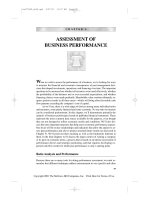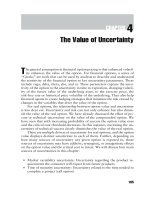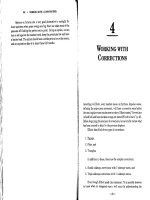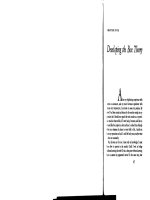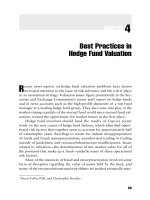Chapter 4 construction
Bạn đang xem bản rút gọn của tài liệu. Xem và tải ngay bản đầy đủ của tài liệu tại đây (336.6 KB, 23 trang )
Financial Accounting II: Construction
Chapter 4
Accounting for construction
Nguyễn Công Phương
Required text:
Barry Elliott and Jamie Elliott (2017), Chapter 21 -Construction contacts, in Financial accounting and reporting, Eighteenth edition, Prentice Hall
Article 27, section 5, Circular 200/2014
Article 79, Section 1.6.11, Circular 200/2014
Chaper 4-Financial accounting 2_Nguyễn Công Phương et al., 2010
© Nguyễn Công Phương 2017
1
Introduction
Contracts that span more than one accounting period
Potential difficulties allocating and recognising revenue and expenses
Potential conflict between prudence and accruals/matching
Objective is to prescribe the accounting treatment of revenue and costs associated with construction contracts, accounting treatment for Projecting Property, Plant, and Equipment
Primary issue is the allocation of contract revenue and costs to the period in which construction work is performed
© Nguyễn Công Phương 2017
2
© 2017 Nguyễn Công Phương
1
Financial Accounting II: Construction
Revenue and costs
Revenues
the initial amount of revenue agreed in the contract, and
variations in contract work, claims and incentive payments
Costs
those that relate directly to a specific contract
costs that are attributable to general contract
activity but can be allocated to specific contracts
any other costs that can be charged to the customer under the terms of the contract
Accounting for construction contracts
by contractor
© Nguyễn Công Phương 2017
© Nguyễn Công Phương 2017
© 2017 Nguyễn Công Phương
3
4
2
Revenue and costs
Costs (cont.)
those that relate directly to a specific contract
Costs of materials, Site labour, depreciation of plant and equipment used on the contract, costs of moving plant and materials to and from the contract site, costs of hiring plant and equipment, costs of design and technical as
costs that are attributable to general contract activity but can be allocated to specific contracts, such as:
Insurance, costs of design and technical assistance that are not directly related to a specific contract, construction overheads.
Costs of this nature need to be allocated on a systematic and rational basis, based on the normal level of construction activity
© Nguyễn Công Phương 2017
5
What is a construction contract ?
© Nguyễn Công Phương 2017
What is a construction contract ?
Potential conflict between prudence and accruals/matching
© Nguyễn Công Phương 2017
© Nguyễn Công Phương 2017
Potential conflict between prudence and accruals/matching
© Nguyễn Công Phương 2017
Potential conflict between prudence and accruals/matching
© Nguyễn Công Phương 2017
Potential conflict between prudence and accruals/matching
Two methods of accounting to recognise the revenue and costs: According to nature of contract
Percentage-of-Completion Method
Recognize revenues and gross profits each period based upon the progress of the construction
Buyer and seller have enforceable rights
Completed-Contract Method
Recognize revenues and gross profit only when the contract is completed
The this method is required to provide the overall contract result can be predicted with reasonable certainty
© Nguyễn Công Phương 2017
© Nguyễn Công Phương 2017
12
Percentage-of-Completion Method
Companies must use Percentage-of-Completion when estimates of progress toward completion, revenues, and costs are reasonably dependable and all the following ex
Contract specifies enforceable rights regarding goods or services by parties, consideration to be exchanged, and manner and terms of settlement.
Buyer can be expected to satisfy all obligations.
Contractor can be expected to perform the contractual obligations
© Nguyễn Công Phương 2017
13
Completed-Contract Method
Companies should use the completed-contract method when one of the following conditions applies:
When a company has primarily short-term contracts, or
When a company cannot meet conditions for using the percentage-of-completion method, or
When there are inherent hazards in the contract beyond the normal, recurring business risks.
© Nguyễn Công Phương 2017
14
The accounting treatment of construction contracts under IAS 11
Two methods of accounting to recognise the revenue and costs: according to payment method
1) Where a construction contract stipulates that the contractor is allowed to make payments according to the set schedule (thanh toán theo tiến độ kế hoạch), and when the outcome of a construction contract can be estimated reliably, the reven
(b) Where a construction contract stipulates that the contractor is allowed to make payments according to the value of performed work (thanh toán theo khối lượng thực hiện), and when the outcome of a construction contract can be estimated
© Nguyễn Công Phương 2017
VN GAAP:
not mentioned
© Nguyễn Công Phương 2017
16
Category 1: When the outcome can be estimated reliably
If the outcome of a profitable contract can be estimated reliably, contract revenue and costs should be recognised by reference to the stage of completio
Options for measuring stage of completion
Costs incurred as a proportion of total estimated
costs
Value certified as a proportion of total contract revenue
Completion of physical proportion of contract work
© Nguyễn Công Phương 2017
17
Options for measuring stage of completion
Value Based Methods
Value of work completed in proportion to total contract price. The value of work may be determined by conduction surveys of work performed, appraisal of the stage completion, normally
Stage of Completion % = (value of work certified as complete x 100)/total expected production or usage (total contract price)
Physical units of work completed in comparison with total number of units to be completed under the contract
Stage of Completion % = Physical Units of Work Completed/ Total Number of Units as per Contract
© Nguyễn Công Phương 2017
18
Options for measuring stage of completion
Cost
Method
ValueBased
Based
Methods (continued)
Costs
incurred
to
date
comparison
totalinexpected
contract
When value basedinmethods
arewith
used
accounting
forcosts
profit making contracts and loss making contracts, revenue is recognized on the basis of work certified as complete
Stage of Completion % = Costs incurred to date
the
amount
of
contract
costs
incurred
to
date
that
have
not yet been charged to the income statement is the contract work in progress
*100/Total expected costs
© Nguyễn Công Phương 2017
When cost based method are used in accounting for profit making contracts and loss making contracts, cost is recognized on the basis of stage of completion whereas contract revenue is measured as the balan
Where outcome in respect of a contract is not certain, stage of completion method is not used to account for the construction contract
© Nguyễn Công Phương 2017
20
19
Thousand
VND
Measurement
revenue according
Example 1: Contract
outcomeofestimated
reliably
Total contract price
2,000,000
ABC Builders LTD is a construction firm. It enters into a 2 year contract for the construction of a building for one of its customers. ABC Builders LTD estimates stage of completion on percentage of cost basis. Following information is available in respect
Total expected costs
1,200,000
to the cost based method
Revenueto date = Total price *(costs incurred to date/ Total estimated costs)
Revenue period i= Revenueto date- Revenueprevious periods
Costs incurred to date
800,000
Progress payments received from customer
700,000
Costperiod i= costs incurred to date – costs
recognised in previous periods
Stage of completion to be determined by reference to costs to date and total costs rather than duration.
Payments according to the set schedule
© Nguyễn Công Phương 2017
21
© Nguyễn Công Phương 2017
22
Example 1 (continued)
Example 1 (continued)
3: Calculate amounts to be recognized in the Balance Sheet for Gross Amounts due to/ from Customers and Trade Receivables
Sept 1: Calculate the stageStep
of completion
receivable
Stage of Completion (%) = [800,000Trade
/ 1,200,000]
x 100 == 900,000 (amount billed) – 700,000 (amount received) = 200,000
66.67 % Gross amounts due from Customers: 1,333,333 (revenue) – 900,000 (amount billed) = 433,333
GrossStatement
amount due for
fromProfit,
customer
represents
amount of revenue earned on a contract but yet billed to the customer
Step 2: Determine the amounts to be recognized in Income
Revenue
andthe
Cost
If bove amount is negative, it is a Gross amount due to customer, represents the amount of revenue earned on a contract in excess of the amount billed to the customer
Thousand VND
Cost
(cost incurred during the year)
800,000
Revenue
(66.67%*2,000,000)
1,333,333
Profit
(revenue – Cost)
533,333
© Nguyễn Công Phương 2017
23
© Nguyễn Công Phương 2017
24
Gross amount due from / to customers
Present “gross amount due from/to customers for contract work” as asset/liability
Gross amount due is calculated as: Costs incurred to date
Plus recognised profit Minus recognised loss
Minus invoiced progress billings
Progress billings invoiced and still receivable at reporting date are presented as trade receivables
© Nguyễn Công Phương 2017
25
Test your understanding
ABC Builders use cost method to calculate the stage of completion of its construction contract. Total estimated contract costs of their contract are $100 million. In the first year of their contr
1. Cost of purchase of raw materials worth $10 million ($5 million of which are unused by the year end)
2. Payment of salaries and wages of $5 million ( $1 million of accrued salaries are unpaid by the year end)
3. Payment of advances to subcontractors of $20 million (Subcontractors have performed work equal to 50% of the amount of advance by the year end)
What is the percentage of Stage of Completion of the construction contract?
© Nguyễn Công Phương 2017
26
Category 2: When the outcome cannot be estimated reliably
Whenacontract‟soutcomecannotbe
estimated reliably:
recognise revenue to the extent of the costs incurred which are expected to be recoverable; and
recognise contract costs as an expense in the period in which incurred.
Example 2: Outcome cannot be estimated reliably
Contract Y at 31 December 2012:
Commencement date:1 November 2012
Completion date:31 March 2014
Contract price:€5,000,000 Cost to date:€400,000
Cost to complete:€3,600,000
This arises during the early stages of a contract when it is difficult to reliably estimate outcome, but likely that costs will be recovered.
Stage of completion to be determined by reference to
costs to date and total costs rather than duration.
Payments according to the set schedule
© Nguyễn Công Phương 2017
27
© Nguyễn
Công Phương 2017
28
Price:
5,000,000
Costs to date:
(400,000)
(3,600,00
Example 2 (cont.)
0)
Costs to complete:
Step 1 Calculate the outcome
for the contract
Profit:
1,000,000
Category 3: When it is probable that total
contract costs will exceed total contract revenue
Step 2 Determine the stage of completion
Therefore
that
the contract =will
Cost to
date/Total cost:
€400,000/€4,000,000
10% incur losses
Too When
early to recognise
any
profit.
it is probable that costs > revenue, the
Step 3 Statement of profit or loss and other comprehensive income
Revenue400,000
Cost of Sales (€4m x 10%) (400,000)
Profit0Revenue = Cost
expected total loss should be recognised immediately irrespective of whether work has commenc
© Nguyễn Công Phương 2017
29
30
© Nguyễn Công Phương 2017
Example 3: Contract loss expected
Example 3 (cont.)
Contract Z at 31 December 2012:
Commencement date:1 September 2012
Step 1 Calculate the outcome for the contract
Price
Contract price:
€2,000,000 20%
% completion:
Completion date:
30 April 2014
Cost to date:
€440,000
Stage of completion to
be determined
by reference
to costs to date and total costs rather than duration.
Cost
to complete:
€1,760,000
Payments according to the set schedule
© Nguyễn Công Phương 2017
31
2,000,000
Step 2 Determine the stage of completion
Cost to Date/Total Cost€440,000/€2,200,000 = 20%
Step 3 Statement of profit or loss and other comprehensive income
Costs to date
(440,000)
Costs to complete
(1,760,000)
Loss
(200,000)
© Nguyễn Công Phương 2017
Revenue (€2m x 20%)
Cost of Sales (€2.2m x 20%)
Provision for foreseeable
32
400,000
(440,000)
(160,000)
loss
(200,000)
Journal entries for revenue
Payments according to the set schedule
At the end of accounting periods, when the outcome of a construction contract can be estimated reliably:
Dr. acc. 337: Progress payment
Cr. acc. 5112: revenue
When amount is billed
Dr. acc. 11X, 131: cash or receivable
Cr. acc. 337
Cr. Acc. 3331: out VAT
© Nguyễn Công Phương 2017
33
Journal entry for revenue
Paymentsaccordingtothevalueof performed work
When amount is billed
Dr. Acc. 11X,131: cash or receivable
Cr. Acc. 5112: revenue
Cr. Acc. 3331: out VAT
© Nguyễn Công Phương 2017
34
Journal entries forJournal
costs incurred
entries for costs incurred
Direct costs relate to the
Construction
specific contract
overheads
or works
are or
of not
contract
directly
(berelated
paid) to a specific contract
Dr. acc.Acc.
627/cr.
152,153,334,214,331,352
(guarantee work);
1413,1363
(sub-contracted
works of internal subcontractor)
Direct materials: Dr. acc. 621/Cr.
152,
331; 1413, 1363 (sub-contracted
works
of internal
subcontractor)
Direct labor: Dr. acc. 622/Cr/acc.
(sub-into
contracted
works of154
internal
subcontractor)
Costs334;
are1413,1363
transferred
the account
according
to the specific contract or works of contract, based on the normal level of construction
Direct labor includes not the social,
unemployment
insurance, and union dues. Its are costs of construction overheads
Dr. acc.healthy,
154/Cr.
621,622,623,627
Machinery and equipment costs
used and
on a specific
contract: Dr.
acc. 623/Cr.
1413,1363 (sub-contracted works of internal subcontractor)
General
administrative
expenses:
Dr.152,214,331;
642
© Nguyễn Công Phương 2017
© Nguyễn Công Phương 2017
35
36
activity
Journal entries for costs incurred
Note (continued):
Costs incurred in excess of the normal level of construction activity are recognized in the income statement: Dr. 632/Cr. 62X
If joint costs of construction machinery and overheads need to be allocated to specific contracts or works of contract:
allocated on a systematic and rational basis, such as:
costs of construction machinery are allocated to each contract or work of contract using used machinery unit (unit equals 8 hours);
construction overheads are allocated to each contract or work of contract based on a direct cost (such as direct materials, direct labor, cost of machinery)
labor37
© Nguyễn Công Phương 2017
Cost of completed work
Cost of completed work = cost of work in process at the beginning + costs incurred during the period – cost of work in process at the end (by reference)
Record the entries
Dr. acc. 632/Cr. Acc.154 : completed work paid
© Nguyễn Công Phương 2017
38
IFRS 15-REVENUE FROM CONTRACTS WITH CUSTOMERS
IFRS 15 was issued in May 2014 and is effective for an entity's first annual IFRS financial statements for periods beginning on or after 1 January 2017. Earlier application is permitted.
IFRS 15 replaces IAS 11 Construction contracts, IAS 18 Revenue and IFRIC 13 Customer Loyalty Programmes
IFRS 15 moves away from a revenue
model
based
onperiod
an „earnings process‟ to an „asset-liability‟ approach based on transfer of control
Amountrecognition
recognised as
revenue
in the
The core principle of IFRS 15 isMethod
that anused
entity
will recognise
revenue
to depict the transfer of promised goods or services to customers in an amount that reflects the consideration (payment) to which the entity expects to
to determine
the revenue
recognised
© Nguyễn Công Phương 2017
Disclosure
Method used to determine stage of completion
For each contract in progress
cost incurred to date and recognised profits (less losses)
amount of advances received
amount of retentions
Gross amount due from customers for contract work where 5 (a)
> (b). This is shown as follows:
cost incurred plus recognised profits, less
the total of recognised losses and progress billings
The gross amount due to customers, i.e. where 5 (a) < 5 (b)
© Nguyễn Công Phương 2017
39
IFRS 15-REVENUE FROM CONTRACTS
WITH CUSTOMERS
To apply this principle, a five-step model framework must be followed:
Step 1: Identify the contract(s) with a customer.
Step 2: Identify the performance obligations in the contract.
Step 3: Determine the transaction price.
Step 4: Allocate the transaction price to the performance obligations in the contract.
Step 5: Recognise revenue when (or as) the entity satisfies a performance obligation.
The industries most impacted by IFRS 15 are likely to be telecom, software development, real estate and other industries with long-term contracts. This includes an industry where bundled contracts
© Nguyễn Công Phương 2017
Accounting for Projecting Property,
Plant by project company
(Supplementary reading: Account 241, Circular 200/2014
© Nguyễn Công Phương 2017
42
Expenditures should be included in the cost of Projecting Property, Plant, and Equipment
1) Journal entries: in case of project company (chủ đầu tư) managing directly the project
Direct costs: Its are usually easily identifiable and can be traced to the asset directly
such
as cost are
of construction
materials,
to contractors,
payroll and benefit cost
Costs
incurred
recorded in the
accountpayment
2412-construction
in progress
If employees work on several projects (e.g., several pieces of equipment), their payroll and benefit costs
should be allocated to each project using labor hours
Dr. 2412
Cr. 152: materials
Indirect costs:
Cr 334: costs related to the employees
its are overhead cost, includes not general and administrative costs
Cr 331: Notes payable to contractors
Indirect costs should be allocated to each project based on a direct cost (such as direct labor)
© Nguyễn Công Phương 2017
Cr:214: Depreciation
Cr…
© Nguyễn Công Phương 2017
44
1) Journal entries: in case of project company managing directly the project
When project is completed (e.g., testing has been performed and Engineering Services approved putting the assets in service), the accumulated cost of th
Dr. 211, 213: costs of fixed assets (approved costs)
Dr. 138: unapproved costs to receive
Dr. 441: approved damages
Cr. 2412: accumulated costs
© Nguyễn Công Phương 2017
45
2) In case of project company managing indirectly the project
A department under project company (ban quản lý dự án) manages directly the project
The project company (chủ đầu tư) uses the
accounting policy applied in the company
Department managing directly project (ban quản lý dự án) uses the accounting policy for project company (see Circular 195/2012/TT- BTC-Chế độ kế toán
Transactions between the project company and its department are internal ones
© Nguyễn Công Phương 2017
46
2) Journal entries: in case of project company managing indirectly the2)
project
Journal entries: in case of project company managing indirectly the project
Accountingbydepartmentunderproject company (tại ban quản lý dự án)
When project is completed (continued)
Costs incurred: Dr. 2411/Cr. 152,334,331,….
Accounting by project company (tại chủ đầu tư)
When project is completed:
Dr. 211,213: cost of assets
Dr. 133: input VAT transferred from department managing project
Dr. (or Cr.) 413: foreign exchange transferred from
department managing project
Cr. 341: long-term borrowing transferred from department managing project, 3388
Cr. 136:
put the assets in service but the project is not approved: Dr. 2412/Cr. 2411
When the project was approved:
Dr. 341,3388 (guarantee deposit),413 (or cr. 413): transferred to the project company
Dr. 441: approved costs
Dr. 138: unapproved costs to receive
Cr. 2412
Cr. 133: input VAT transferred to the project company
© Nguyễn Công Phương 2017
47
© Nguyễn Công Phương 2017
48




